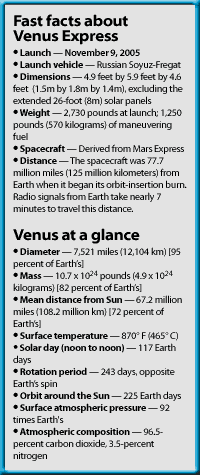
More Astronomy resources:
Astronomy news
This week’s sky events
Astronomy basics
Glossary of astronomical terms
Return to Astronomy “For the media” page
April 5 – First Quarter Moon occurs at 8:01am EDT
April 6 – The Moon passes 4° north of Saturn at 7pm EDT
For more information, contact:
Matt Quandt
[t] 262.796.8776 x419
[e] mquandt@astronomy.com
April 5, 2006
Matt Quandt
[t] 262.796.8776 x419
[e] mquandt@astronomy.com
April 5, 2006
Astronomy offers publication-quality images below.
WAUKESHA, WI – The European Space Agency’s (ESA) Venus Express spacecraft is expected to fire its engine and settle into orbit around Venus early April 11. The 50-minute maneuver will slow the vehicle’s 18,000 mph (29,000 km/h) velocity relative to Venus by about 15 percent, allowing Venus Express to be captured into orbit around the planet.
Venus Express launched from Kazakhstan’s Baikonur Cosmodrome on a Russian Soyuz-Fregat rocket November 9, 2005, and cruised through space for 153 days (Astronomy.com: “Venus Express is up and away”). It’s the first probe dedicated to studying our neighbor planet since NASA’s radar-mapping Magellan mission plunged into Venus’ atmosphere in 1994.
Venus Express will focus on the planet’s dense, poorly understood atmosphere. Clouds at the equator circle the planet in just 4 days, a phenomenon scientists call super rotation. Although scientists have identified sulfuric-acid droplets in Venus’ upper cloud deck, spacecraft passing through lower clouds suggest the presence of solid particles – a hint of unknown chemical processes there. Lightning may occur in these clouds – or nearer the surface in plumes from possible erupting volcanoes – but no space probe has returned definitive evidence. ESA ground controllers will adjust the probe’s orbit through May 6. Eventually, Venus Express will loop around the planet’s poles at altitudes ranging from 155 miles (250 km) to 41,000 miles (66,000 km). When Venus Express achieves this orbit, its primary mission will begin.
The spacecraft’s Venus Mapping Camera will be the first to study the planet at wavelengths across the spectrum, from the infrared to the ultraviolet. It will even be able to look for hot spots on the surface possibly caused by volcanic eruptions in progress. Although the Venus Mapping Camera was developed for Venus Express, most of the instruments were built from flight-qualified spares for two ESA missions already flown – Mars Express and Rosetta.
Mission planners expect the mapping mission to last 500 Earth days. But Venus Express carries enough fuel to maintain its polar orbit twice this long.
Evil twin
The planet Venus outshines everything in the sky except the Sun and Moon. It’s Earth’s closest planetary neighbor, orbiting the Sun about 30 percent closer. When Venus passes between Earth and the Sun, the planet lies only about 100 times farther away than our own Moon.
Venus is shrouded by a thick mantle of clouds, which hid its true character until the 1950s. Until then, astronomers thought of Venus as Earth’s twin based on bulk similarities, like size, mass, and distance from the Sun.
But Venus’ perpetual clouds are made of sulfuric acid, not water. The dense carbon-dioxide atmosphere presses onto the surface so much with a force similar to that experienced thousands of feet below the surface of Earth’s oceans. Spacecraft have landed on the Venus – notably the Russian Venera spacecraft of the 1970s and 1980s – but they didn’t survive long.
Venus has no oceans, lakes, rivers, or rainfall. The planet’s high surface temperature – a constant 870º Fahrenheit (465º Celsius), hotter than an oven’s broiler – prevents any liquid water. The thick carbon-dioxide atmosphere insulates the planet, reducing its ability to radiate heat into space, so the surface temperature rises. Call it global warming gone wild.
Yet, scientists think Venus may once have held oceans, just like Earth, and they’d like to understand why the two worlds are so dissimilar now.
Astronomy and Astronomy.com will provide extensive coverage of the Venus Express.









